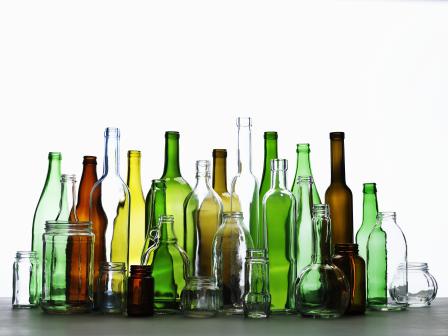Glass: Material-Specific Data
Glass is found in municipal solid waste (MSW), primarily in the form of containers such as beer and soft drink bottles; wine and liquor bottles; and bottles and jars for food, cosmetics and other products. Although most of the data is on glass containers, this analysis also considers glass materials in durable goods like furniture, appliances and consumer electronics.
This web page is a brief summary of glass material-specific data. For more comprehensive information, see the 2018 Data Tables on the Advancing Sustainable Materials Management: Facts and Figures Report page.
On this page:
Overview
 EPA measures the generation, recycling, composting, combustion with energy recovery and landfilling of glass materials.
EPA measures the generation, recycling, composting, combustion with energy recovery and landfilling of glass materials.
EPA used statistics from the Glass Packaging Institute’s numbers on glass container shipment to estimate glass container generation. In 2018, glass generation in all products was 12.3 million tons in the United States, which was 4.2 percent of all MSW generation.
EPA combined data from the Glass Packaging Institute with information from state environmental agencies to measure the recycling of glass containers in the United States. The amount of recycled glass containers was 3.1 million tons in 2018, for a recycling rate of 31.3 percent.
The total amount of combusted glass in 2018 was 1.6 million tons. This was 4.8 percent of all MSW combustion with energy recovery that year.
In 2018, landfills received approximately 7.6 million tons of MSW glass. This was 5.2 percent of all MSW landfilled that year.
Please see the EPA Methodology Document for information on estimating glass generation and management.
Summary Table and Graph
The data below are from 1960 to 2018, relating to the total number of tons of glass generated, recycled, composted, combusted with energy recovery and landfilled.
| Management Pathway | 1960 | 1970 | 1980 | 1990 | 2000 | 2005 | 2010 | 2015 | 2017 | 2018 |
|---|---|---|---|---|---|---|---|---|---|---|
| Generated | 6,720 | 12,740 | 15,130 | 13,100 | 12,770 | 12,540 | 11,520 | 11,470 | 12,300 | 12,250 |
| Recycled | 100 | 160 | 750 | 2,630 | 2,880 | 2,590 | 3,130 | 3,190 | 3,070 | 3,060 |
| Composted | - | - | - | - | - | - | - | - | - | - |
| Combustion with Energy Recovery | - | 60 | 300 | 1,810 | 1,790 | 1,660 | 1,360 | 1,440 | 1,650 | 1,640 |
| Landfilled | 6,620 | 12,520 | 14,080 | 8,660 | 8,100 | 8,290 | 7,030 | 6,840 | 7,580 | 7,550 |
Source: Glass container information is from the Glass Packaging Institute and state environmental agency websites.
A dash in the table means that data is not available.
